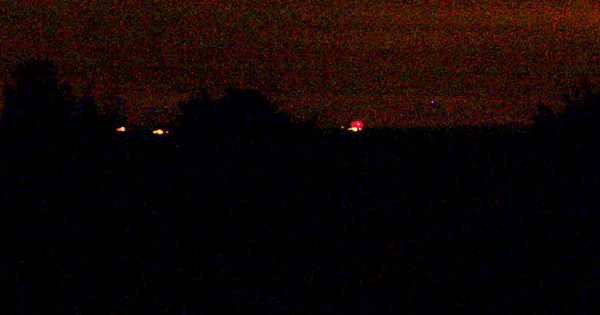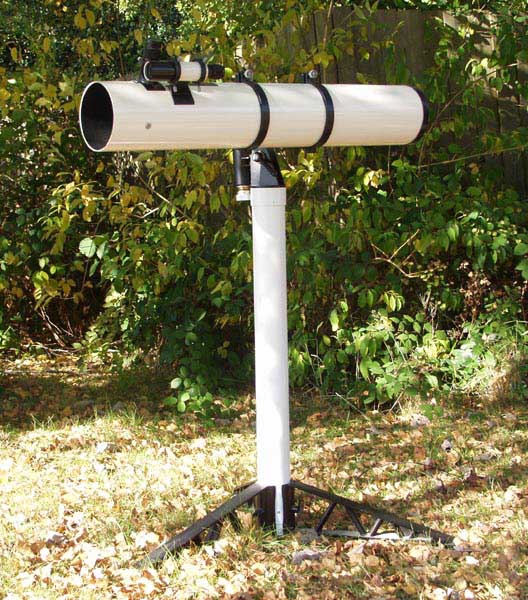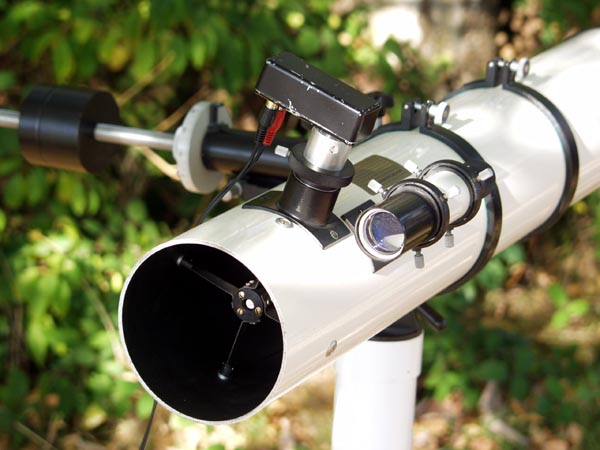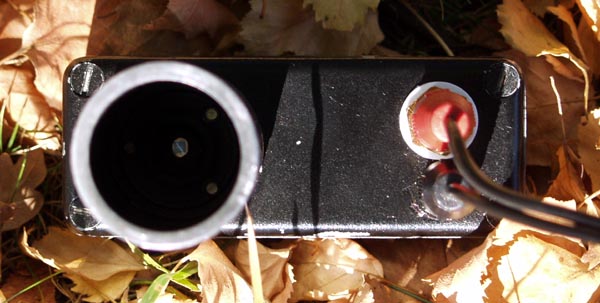UK Laser Record - 76.1 km Contact
G8LSD
e-mail allan@r-type.org
G0MRF's Laser as seen from Ashdown
Wednesday 8th October 2003. It started with a trip to Tunbridge Wells. On the return leg the air seemed very clear so I went via the Forest. In the binoculars I could see the towers on Truleigh Hill, the trees at Chanctonbury, then quite easily I found the twin masts at Bignor (50 km+) then the television mast north of Midhurst and finally I saw the stubby mast at Butser. Prior to this I had only seen Butser with the aid of the telescope. From that point it all moved with great speed.
I was on site with all the gear by 16:45 clock time. The conditions had deteriorated and to the left of the Midhurst television mast was only mid distance hills. The cloud was very thick and black and rain looked very possible. The 70cm talkback (433.400 FM) was difficult to establish as the wind kept blowing the nine element beam round on the lighting stand that I used as a mast. The telescope was set-up and confirmed that Butser was not visible. The orange tinted light was, however, appearing above the South Downs as a thin slit before the cloud darkened the sky. The effect was to make the top of the hills glow and be exceptionally clearly defined. By Chanctonbury the cloud covered the top of the Downs and it was less easy to make out details. At Bignor the hill merged into the sky as though rain was falling. I could still see the mast at Midhurst and it was obvious that visibility was extending only just past 50 km. Still exceptional but less that earlier. I spoke to G3JMB on 70 cm and waited for G0MRF to arrive on site.
The Russian 4.5 inch telescope.
The equatorial mount has been modified to give direct azimuth and elevation control
I was standing by the road and had gone from shirt and jumper to adding the fleece and water/wind proof cagoule in the space of 20 minutes. David, at Butser, had to carry all the equipment to the top of the hill and had no wind protection at all. When we had established talkback the visibility had dropped to a disappointing degree. The telescope was aimed at the dip on the horizon that Butser should have been standing in. The horizon was a uniform grey and was upside down and at a 45 degree angle, courtesy of the 4.5 inch Russian reflector telescope.
The wind was gusting and making the image in the telescope jump inspite of the very heavy mounting base. David could not operate from the chosen point as the local vegetation was higher than the top of the tripod. He had to move and make a second long treck to the car for the second box of equipment. Due to the back packing required at Butser, David did not have the power for a beacon light. Any location aids had to come from the Ashdown end. I had 250 Amp Hours of 13.8 volts from the batteries under the back seat of the vehicle and the associated switch mode converter, as well as 240 Volts AC from the inverter run from the starting battery. By the time David had found a suitable location the visibility had dropped even further, but the wind had not abated.
We then set about converting the operating plan into something that suited the conditions. David swept the laser over the angle that included Ashdown. In the past the beam width was sufficient for this to work. This time the telescope showed no sign of even the briefest of flashes of the characteristic red. Plan B time.
The cloud was passing over the Downs to the south of me and the wind was dropping. I set up the laser transmitter, held in place with the weight of an 80 Ah leisure battery, and wired up both transmitter and receiver. A second set of scans with the laser at the Butser end also failed to give any tone in the receiver. The strobe light operated from Ashdown had no path to Butser. Time was passing. Amid the head scratching I wend back to minute scanning of the horizon with the telescope. By now a beautiful sunset was developing and the sky was a vivid orange through the broken cloud. For one moment I thought I could see as a very faint change in the uniform colour of the horizon the inverted bathtub shape of Butser. I aimed the telescope at the northern end where the mast is to be found. Again no contact. By taking note of the local terrain I had a good idea as to the aiming point and so set up my laser onto the target. David saw nothing. Light was fading fast and I expected the horizon to go black before I had a clear fix. As David had no beacon this would have ended the contact.
Returning to the telescope revealed a point of light from a mercury vapour lamp at probably 45 to 50 km away. This was not visible with binoculars or through the rifle sight on the transmitter. David still could see nothing. A sweep of his laser showed no flashes in the telescope. The sunset was fading into a beautiful burnt orange.
The telescope with eyepiece replaced by receiver head unit.
The wind had dropped even more. Once again I closely scanned the horizon. First I saw the faint outline of Butser hill and then for a moment I imagined that the mast was visible against the darkening grey orange. A few minutes later after talking on the 70 cm link I returned to the telescope. Several points of mercury vapour lamps acted as a horizontal grid and slightly above them was the mast on the top of Butser. The binoculars and rifle sight still showed nothing but the points of light, almost blurred into a single point, gave enough information to aim the laser. David saw nothing.
Next, as it was now quite dark and approaching 20:00 I switched on the torch. David saw it almost at once. He still could not see the laser, even though it was directly aimed at him. He swept his laser at the point where the torch had been and I saw a brief flash of red. It was momentarily bright but did not stay visible. I moved the talkback from the van to a box by the receiver and even giving a running commentary we could not get more than brief flashes of the laser.
Looking into the laser receiver head unit. The sensor within the OPT211 can be seen.
I returned to my laser and started a systematic scan of the horizon. On one occasion I turned the vertical control too far, and so I was seeing into the hill in the rifle sight. David saw the beam. Once again the rifle sight prism had dropped and the sight had lost vertical accuracy. It was still spot on in the horizontal plane. David now relayed the signal back over the 70 cm FM link. With this feedback I could optimize the pointing and we established one way contact.
The CW signal was clear and lacked the usual scintilation. The brightness was such that David reported that I was not the brightest light on the horizon. We then concentrated on receiving David's signal. It was critical in adjustment but once I could get a faint signal in the receiver he was able to optimise by the usual feedback route. It was 19:00 UTC and 135 minutes standing by the road. Exchanging callsigns, reports and random characters went quickly - just a few minutes. David has a active filter on receive tuned to 488 Hz, our tone frequency. I suggested that we may try my audio. In the past this has not worked, but as scintillation was at an all time low it seemed worth a second try. Once the microphone had made proper contact in its socket the audio came out loud and clear. It was 19:15 UTC and a 5 by 7 report on the audio was received.
To get further evidence of this result we contacted G3JMB again and he pointed his beam onto Butser to receive David's 70 cm transmission. While this was being set-up we kept the conversation going in a cross band full duplex contact. Jack (G3JMB) made contact and David relayed my audio to him. He was then hearing Pulse Width Modulation to a 3 mW laser diode being received on a CW optimised receiver and re transmitted the 50 km to his QTH via a hand held rig from a windy hill. It was a surreal moment. Then we reversed the process and I re transmitted David's CW to Jack.
At 19:45 UTC we closed the laser link that had been stable for 30 minutes and packed up. A magical night and a new UK record of 76.1 km.
Updated 18 OCT 2003



